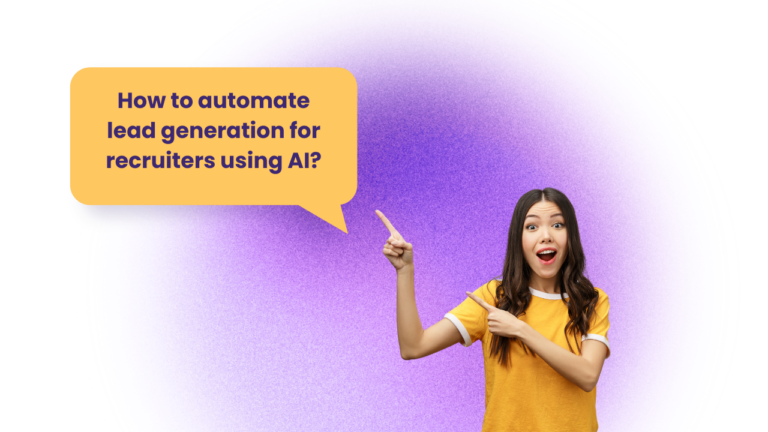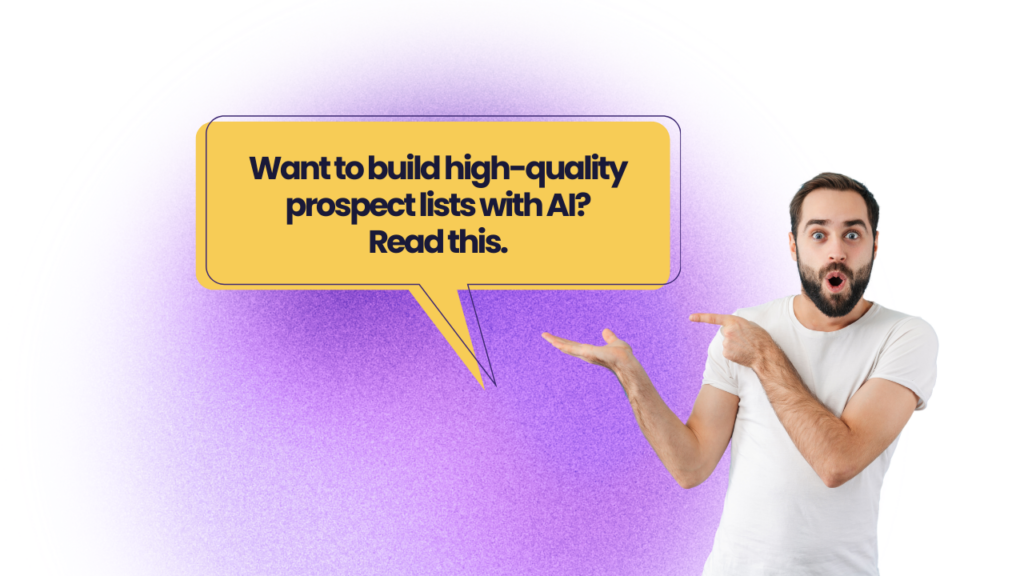When it comes to business growth, lead generation for recruiters is more than just a mere operational task; it’s the lifeblood of your business. For recruitment agencies, one of the biggest challenges has been to continually keep their client pipeline filled while balancing resource allocation.
The challenge here lies in identifying tactics & methods which can help them identify, attract & nurture leads throughout the recruitment process.
Traditional client acquisition methods, although essential, are often time consuming and labor intensive. This is where the use of AI comes into the picture, with tools like Clay, which have transformed how lead generation for recruitment agencies happens.
In this article, we’ll take an in-depth look at how companies can automate lead generation for recruiting and the benefits of using Clay for your recruitment business in the long-run.
So let’s get started.
How to Create a Lead Generation Strategy for Recruitment Agencies?
Before we get started with automating lead generation for recruiters, it’s important to have a proper lead generation strategy in place for your recruiting firm. Here are the most important steps to follow when crafting a lead generation strategy for your recruitment agency:
1. Craft an Ideal Customer Profile (ICP)
As stated previously, the ideal customer profile is an extremely important aspect of any lead generation effort. When you know your customers inside out, you can not only tailor your messaging accordingly, but also prepare targeted outbound prospecting lists for lead generation.
Crafting an ideal customer profile (ICP) also helps you create buyer personas which can then be used to visualize who your ideal customer is, the kind of job titles they hold, the number of stakeholders involved and so on.
This tailored approach ensures that resources are focused on the right prospects, and also helps avoid time wastage.
2. Identify the best lead generation channel
Selecting the right channel for lead generation for recruitment is critical. There are multiple ways you can generate leads (and clients) for your business, such as – SEO, paid ads, email marketing and cold calling among others.
When it comes to lead generation for recruiters, we’ve found cold email marketing to be the most effective channel to acquire more clients.
With a 40% better success rate compared to channels like Facebook & Twitter, and the personalized nature of communication, email marketing is the best channel for lead acquisition for recruiting firms.
At the end of the day though, the choice of a lead generation channel should depend on factors like the budget, average sales cycle for client acquisition & how effectively you can reach your intended audience.
3. Set measurable goals
When considering lead generation for recruiters, make sure to set quantifiable goals for your sales teams. Having a B2B sales process with the right projections for achieving your goals is more likely to get you results than opting for a “spray-and-pray” approach.
You can also leverage the relevant KPIs and metrics to measure success & refine strategies accordingly.
4. Evaluate performance
Once you’ve created the required sales assets & launched your campaigns, make sure to evaluate performance based on the metrics zeroed-in from the previous step. Analyze what’s working and what isn’t and test multiple angles to see what gets you the desired results.
Make sure to keep an eye out for any drop in performance when starting a new campaign or scaling an old one.
5. Optimize and scale
The ability to adapt and expand successful lead generation strategies is fundamental, and helps you achieve consistent results with your customer acquisition efforts. When using email, you can test out different offers, increase sending volume or simply write better outreach messages that resonate with your ideal customer.
Once you’ve found the winners, make sure to push them further & maximize their potential.
Lead Generation for Recruiters Using AI – Step-by-Step Process
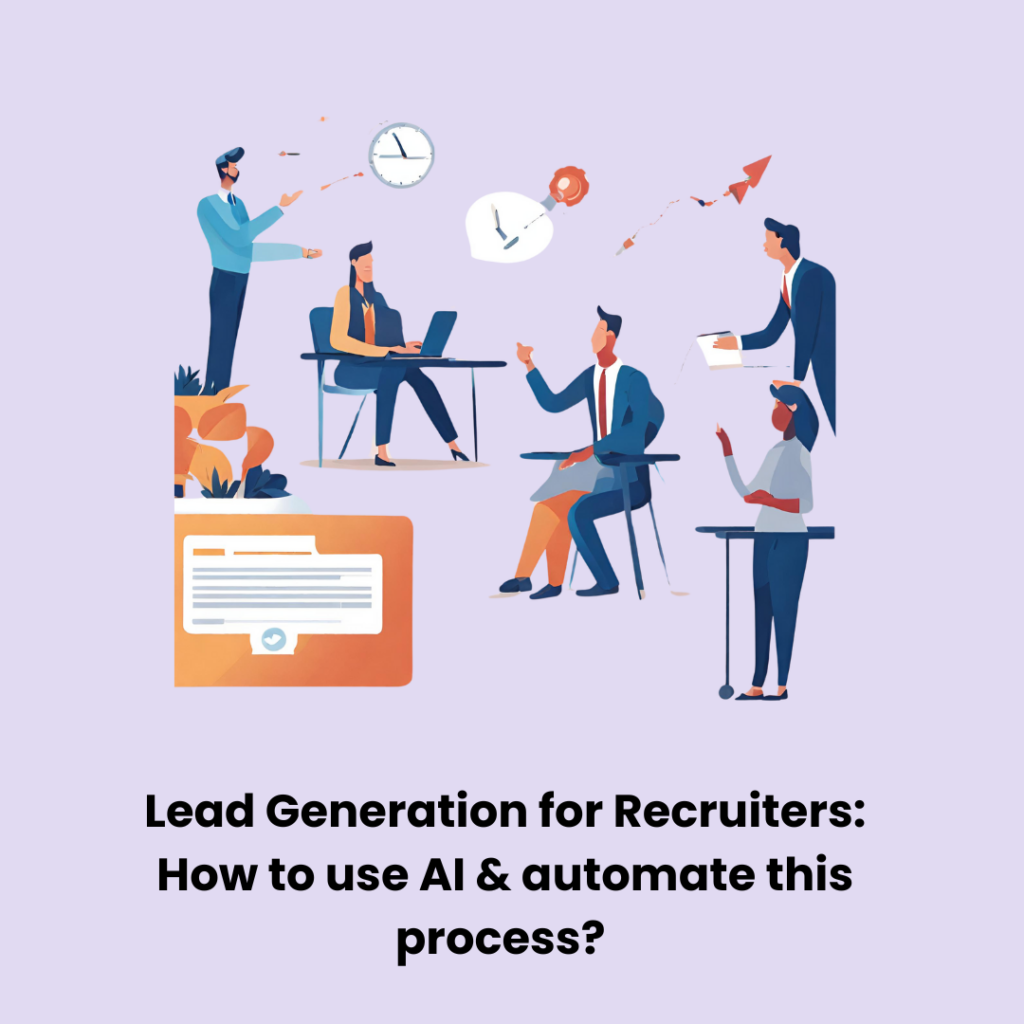
While traditional methods of finding companies & their stakeholders is a time-consuming process, you can choose to automate lead generation for recruiters using AI tools like Clay.
These tools not only help you save time, but also the resources involved. As with any other automation tool, it also removes the chances of error that sometimes arise with manual effort.
Here’s how you can start automating lead generation for recruiting firms using AI workflows:
Step 1: Gathering data
The first step to use AI for recruitment agency lead generation is to gather a list of potential companies and decision-makers that you can reach out to.
Having a huge list with thousands of decision-makers & companies is good, but you’ll need to further narrow down your research in order to have the best chance of converting them into customers.
By filtering for the right list, your team can concentrate on connecting with the right people who have the best chance of conversion, rather than sifting through hoards of irrelevant data.
In the next few paragraphs, we’ll show you how to automate the manual research process with AI.
Step 2: Automate your manual research with AI
The next step is to automate your manual research with AI, which will be done using 3 prominent playbooks (or approaches) we’ve found to work extremely well for recruitment agency lead generation.
With the help of Clay’s AI capabilities, we’ll be able to automate our lead research, enrich the data and launch high-converting outreach campaigns.
Here’s how:
Approach 1: Using the ‘Open Jobs’ playbook
- Automatically find open jobs using AI
Using AI to automate lead generation for recruiters starts with sourcing a curated list of open job positions.
Dubbed as the ‘Open Jobs’ playbook, it is one of the most commonly-used practices in the recruitment industry, where you configure Clay to scrape job boards and career pages for open positions that align with your area of focus.
To do this, simply go to the workspace and click the ‘Find Jobs & Companies’ option after choosing the ‘New table’ & option and then click on ‘Find Jobs on LinkedIn’.
Once you’ve chosen this option, you can further filter down the results based on criteria like ‘Companies’, ‘Job titles’ & ‘Experience’ and import them to the Clay table.
- Enrich the data
Once you’ve imported the list of open job positions, you can enrich it further by adding the job description. To do this, click the ‘Add Enrichment’ next to the last data column, followed by clicking on the ‘Find Active Job Openings via LinkedIn’ and then choose company URL as the company identifier.
Once you’ve done this, follow it up with adding further criteria such as the job title keywords, and the job description before saving it and running the operation.
- Use AI for personalization
The next step when you’re looking to automate lead generation for recruiters is to use AI for pulling out information on the qualities required for any candidate to succeed in the given job role.
You can do this by running a GPT prompt that generates an inference based on the input about the qualities a candidate must have to succeed in the given role.
Keep the prompt as detailed as possible, adding all the necessary details required to generate the desired inference for specific job roles.
Approach 2: Using traction metrics
Another extremely useful approach to AI-led lead generation for recruiters is to use traction metrics, which simply put, are indicators or growth signals which are As per this approach, you might want to try and get the companies before they post a job.
Here’s how you can use them to power your outreach:
- Scraping website data
The first step to use the ‘Traction Metrics’ approach is to scrape the required website data (especially for the last 3 months). Now this can be done by scraping the website data off SimilarWeb using the Claygent tool inside Clay, or via a third-party tool like Apify.
The idea here should be to look at companies whose website data has shown a significant spike in the last 3 months.
Some of the metrics you could track here include:
- Employee headcount growth
- New fundraising
- Opening a new office
- Social media followers gained
Now you don’t know if the companies are actually hiring, but the traction metrics can actually help you predict as and when the prospect might advertise a new job position.
- Add Enrichment
Once the website data is scraped, you can enrich the data further by checking if the companies have an internal recruiter. To do this, you can use the ‘Find Employee Headcount by Job Title’ criteria, followed by mapping it with the company URL.
You can further enrich the data by adding potential job titles like ‘human resources’, ‘recruiter’. In case the companies don’t have an internal recruiter, you can tailor your pitch accordingly and reach out to them with your services.
Approach 3: Using employee departure data
The third playbook or approach you can use is the employee departure data, which involves monitoring companies for recent departures and offering your services to fill in the gaps.
This approach needs you to time your outreach well, but can be highly rewarding because you’re offering a solution at a critical time for the company.
Here’s how you can use employee departure data to automate lead generation for recruiters:
- Scrape people data
Similar to the previous two approaches, here you can scrape the relevant employee data by clicking the ‘Find People on LinkedIn’ option and find people who have recently left their jobs.
Unlike the usual routine where we find people’s data to reach out to them with a relevant solution, here we’ll use the scraped information to reach out to decision-makers from companies where the people on our list have previously worked.
- Enrich the data using LinkedIn profile
Yet again, we’ll enrich the existing data with more information, which in this case, happens to be the prospect’s LinkedIn profiles. You can choose the ‘Enrich Person from Profile’ option and then narrow down the results based on additional criteria like their past work experience, start and end data from the previous job, alongside company domain among others.
You can use the ‘Formula Generator’ option to check if the end date of their previous job is from 3 months ago.
- Find relevant contacts
Once you’ve enriched the list and narrowed it down based on different criteria, you can create another row to find contact details of decision-makers from companies using the ‘Find Contacts at Company’ option.
Once you run the operation, click any of the rows and instruct Clay to write each line to a new table.
Step 3: Use AI to personalize your recruiting emails
The next step to automate lead generation for recruitment agencies is to personalize your emails using AI, which can be easily done with all the raw data at your disposal.
You can use ChatGPT-4 to either write full-fledged cold emails or to insert custom variables in an existing email script by adding the right amount of information required to return a result.
Step 4: Launch your campaigns
Once the emails have been personalized, you can easily launch your outreach campaigns on Smartlead or Instantly, whichever works best for you.
By following these above mentioned steps, you can easily automate the lead generation for recruiters and start getting new leads for your business.
Benefits of Using Clay.com to Automate Lead Generation for Recruiters
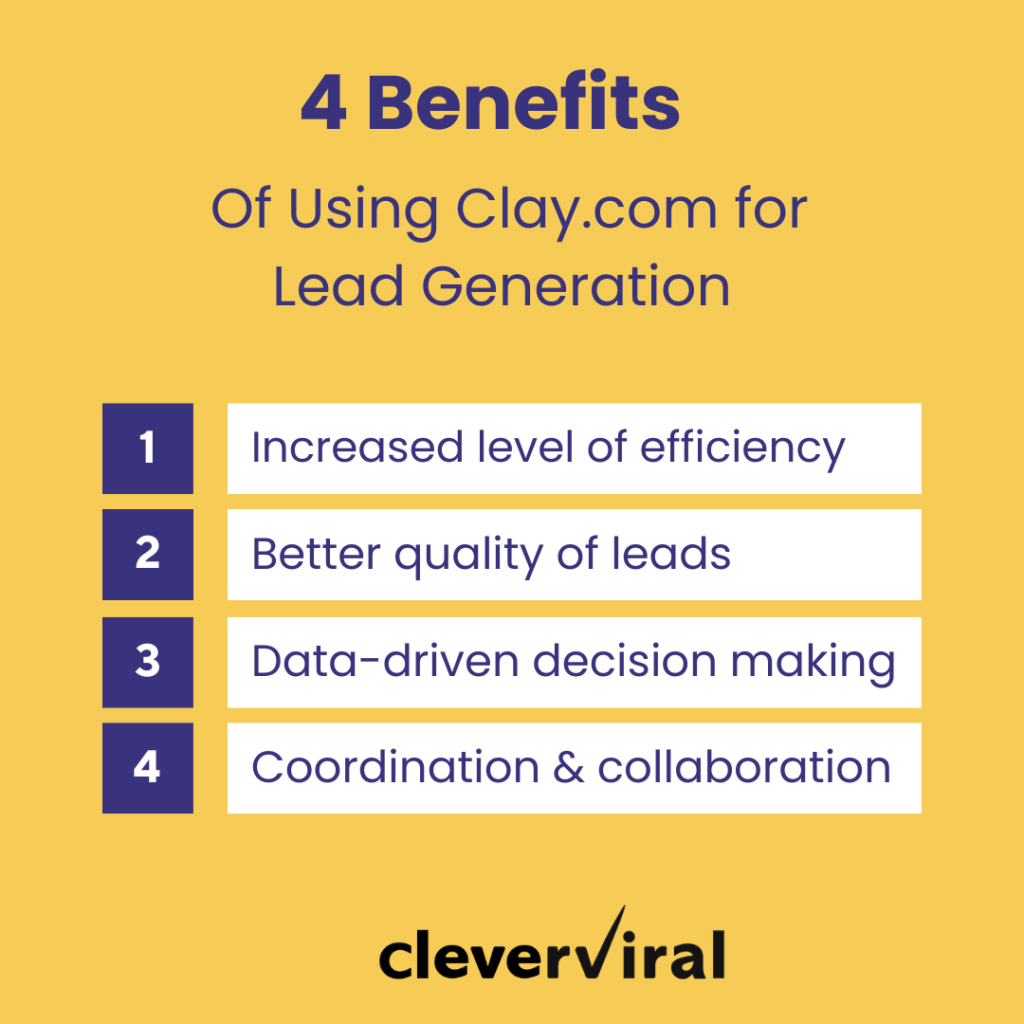
When it comes to generating leads for recruiters, Clay is one of the most useful tools to automate and streamline your lead generation processes, offering recruiting agencies the following benefits:
- Increased efficiency: One of the standout benefits of using Clay to automate lead generation for recruiters is the increased level of efficiency it offers. By automating both data collection and analysis, Clay eliminates the need for spending time undertaking manual processes.
This is extremely crucial in the fast-paced recruitment industry, where speed is often a key deciding factor.
2. Better quality of leads: Another great benefit of using Clay for lead generation for recruiters is the quality of leads it produces. Unlike traditional methods that rely on a broader criteria, Clay’s advanced algorithms enable more precise targeting based on various data points.
This approach ensures that the leads generated are not only numerous but also highly relevant and more likely to convert.
3. Data-driven decision-making: Using Clay to generate leads for recruitment agencies enables data-driven decision-making, with actionable insights drawn from real-time data.
This feature is invaluable for strategizing marketing efforts, understanding market trends, and identifying emerging opportunities in the recruitment sector. With access to up-to-date analytics, recruitment agencies can adapt their strategies to changing market conditions, ensuring that they remain competitive.
4. Collaboration & coordination: Clay.com also facilitates enhanced collaboration and coordination within recruitment teams. The platform’s user-friendly interface and shared dashboards allow team members to access critical information effortlessly, ensuring that everyone is on the same page.
Final Thoughts
So this is everything you need to automate lead generation for recruitment agencies. By adopting the approaches and playbooks mentioned above, companies in the recruitment space can start generating leads for their business in just a few clicks.
This is much better than doing everything manually, and avoiding a process that’s not only effort-intensive but also prone to errors.
We, at Cleverviral, help B2B companies set up AI-powered outbound systems that help them generate new sales opportunities on autopilot. If you’re a recruitment or staffing solutions provider looking to predictably grow your lead generation, reach out to us on [email protected] and our experts will shortly get in touch for further discussions.
Until then, happy prospecting!
Frequently Asked Questions
What is lead generation in recruiting?
This is a crucial aspect for both recruitment agencies and independent recruiters, as it helps them establish a steady stream of clients alongside ensuring ongoing business opportunities and growth.
How do you find leads in recruitment?
They sometimes also leverage job posting sites, industry forums, and professional events to gather information about organizations looking to hire.
What are the best methods to obtain new recruitment leads?
If you’re looking to generate leads for your recruitment business, this is the ideal way forward.
